In this companion to our October 29 column, “Books from Down Under,” we feature books that originated in the United Kingdom. Included are new titles by some of the British authors and illustrators with extensive bodies of work who have won national and international recognition and are popular with readers on both sides of “the pond.”
Ages 4–8
Hide and Seek. Anthony Browne. 2018. Candlewick.
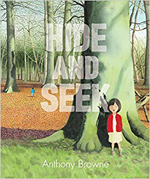 Poppy and her younger brother, Cy, who have been sad since their dog, Goldie, went missing, decide to cheer themselves up by playing hide-and-seek. As Poppy counts to 10, Cy runs off into the woods near their home and hides in a structure he finds built from a tangle of branches. Browne’s use of perspective contributes to the increasing suspense, with trees looming large and shadows darkening as Poppy moves deeper and deeper into the woods and begins to worry that Cy went too far. Cy begins to wish that Poppy would find him. Poppy hears a noise. Cy does too. The story ends with a joyful reunion of Cy, Poppy, and Goldie. An extra bonus for readers comes with the search for items hidden in Browne’s surreal paintings. (Anthony Browne lives in Kent, England.)
Poppy and her younger brother, Cy, who have been sad since their dog, Goldie, went missing, decide to cheer themselves up by playing hide-and-seek. As Poppy counts to 10, Cy runs off into the woods near their home and hides in a structure he finds built from a tangle of branches. Browne’s use of perspective contributes to the increasing suspense, with trees looming large and shadows darkening as Poppy moves deeper and deeper into the woods and begins to worry that Cy went too far. Cy begins to wish that Poppy would find him. Poppy hears a noise. Cy does too. The story ends with a joyful reunion of Cy, Poppy, and Goldie. An extra bonus for readers comes with the search for items hidden in Browne’s surreal paintings. (Anthony Browne lives in Kent, England.)
—CA
How to Be a Lion. Ed Vere. 2018. Doubleday/Random House.
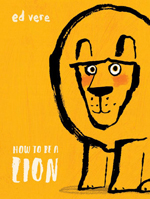 Leonard is intent on dispelling stereotypes about the characteristics of lions. “There are so many ways that you can be you,” he says. Instead of fierce, he is gentle. Instead of loud he is quiet. Leonard befriends Marianne the duck, and the unlikely pair play, go on walks, have long conversations, and watch for shooting stars together. Marianne even helps Leonard write his poems that counter misconceptions about lions. Ed Vere uses thick black lines and bright yellow and orange colors to create the illustrations for this delightful picture book with a gentle lesson about knowing who you are and thinking for yourself when others try to tell you how to behave. Reading How to Be a Lion aloud may also invite discussion about the relationship between humans and the world’s endangered lion population. (Author/illustrator Ed Vere lives in London, England.)
Leonard is intent on dispelling stereotypes about the characteristics of lions. “There are so many ways that you can be you,” he says. Instead of fierce, he is gentle. Instead of loud he is quiet. Leonard befriends Marianne the duck, and the unlikely pair play, go on walks, have long conversations, and watch for shooting stars together. Marianne even helps Leonard write his poems that counter misconceptions about lions. Ed Vere uses thick black lines and bright yellow and orange colors to create the illustrations for this delightful picture book with a gentle lesson about knowing who you are and thinking for yourself when others try to tell you how to behave. Reading How to Be a Lion aloud may also invite discussion about the relationship between humans and the world’s endangered lion population. (Author/illustrator Ed Vere lives in London, England.)
—CBB
Mouse House. John Burningham. 2018. Candlewick.
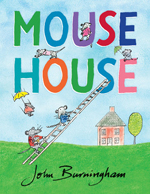 With a simple text and his signature scribbly, watercolor-washed artwork, author/illustrator John Burningham tells the story of a family of mice living in the house of a human family (a father, mother, boy, and girl). On his way to bed, the boy sees a mouse, and the father phones the mouse catcher to come the next morning. Before going to bed, the children write a note to the mouse family warning them to get out of the house, and they do. The boy and girl watch the mouse children playing in the backyard each evening until they disappear with the first snowfall. They don’t know where the mice have gone until the boy once again sees a mouse on his way to bed. “But he doesn’t say anything at all.” (John Burningham lives in London.)
With a simple text and his signature scribbly, watercolor-washed artwork, author/illustrator John Burningham tells the story of a family of mice living in the house of a human family (a father, mother, boy, and girl). On his way to bed, the boy sees a mouse, and the father phones the mouse catcher to come the next morning. Before going to bed, the children write a note to the mouse family warning them to get out of the house, and they do. The boy and girl watch the mouse children playing in the backyard each evening until they disappear with the first snowfall. They don’t know where the mice have gone until the boy once again sees a mouse on his way to bed. “But he doesn’t say anything at all.” (John Burningham lives in London.)
—CA
Neon Leon. Jane Clarke. Ill. Britta Teckentrup. 2018. Nosy Crow/Candlewick.
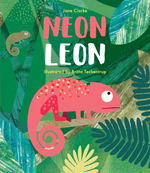 The reader is oriented to Neon Leon by the minimalist representation of only Leon’s eye and a straight line for a mouth on the neon orange front endpaper. Leon is a chameleon and, although most chameleons can change color, Leon cannot. He remains bright orange in all surroundings. Leon’s facial expressions clearly show that he is sad and feels like he doesn’t fit in anywhere. This postmodern picture book requires the reader to interact by answering questions, responding quietly and loudly, softly turning the pages when Leon goes to sleep, making predictions, and counting. Is there a place where Leon fits in? Young children will delight in the perfect ending of the story and in seeing Leon’s sad, straight line of a mouth curved into a smile on the back endpaper. (Jane Clarke lives in Kent, England; Britta Teckentrup lives in Berlin, Germany.)
The reader is oriented to Neon Leon by the minimalist representation of only Leon’s eye and a straight line for a mouth on the neon orange front endpaper. Leon is a chameleon and, although most chameleons can change color, Leon cannot. He remains bright orange in all surroundings. Leon’s facial expressions clearly show that he is sad and feels like he doesn’t fit in anywhere. This postmodern picture book requires the reader to interact by answering questions, responding quietly and loudly, softly turning the pages when Leon goes to sleep, making predictions, and counting. Is there a place where Leon fits in? Young children will delight in the perfect ending of the story and in seeing Leon’s sad, straight line of a mouth curved into a smile on the back endpaper. (Jane Clarke lives in Kent, England; Britta Teckentrup lives in Berlin, Germany.)
—CBB
The Night Box. Louise Greig. Ill. Ashling Lindsay. 2018. Clarion/Houghton Mifflin.
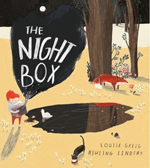 As day ends, young Max has an important task to perform before going to sleep. He turns the key in the Night Box in his bedroom—“CLICK / and another / click . . . / Up comes the lid . . . / WHOOSH! / Day slips inside as Night sweeps out.” And when tired Night returns to the boy’s bedroom after his job is done, Max opens the box and “WHOOSH! / Night slips inside as Day sweeps out.” The lyrical language of Scottish poet Louise Greig’s text and Irish artist Ashling Lindsay’s mood-setting illustrations of their debut picture book tell a gentle story of the magic of the natural world in the cycle of day and night. (Louise Greig lives in Aberdeen, Scotland; Ashling Lindsay lives in Belfast, Ireland.)
As day ends, young Max has an important task to perform before going to sleep. He turns the key in the Night Box in his bedroom—“CLICK / and another / click . . . / Up comes the lid . . . / WHOOSH! / Day slips inside as Night sweeps out.” And when tired Night returns to the boy’s bedroom after his job is done, Max opens the box and “WHOOSH! / Night slips inside as Day sweeps out.” The lyrical language of Scottish poet Louise Greig’s text and Irish artist Ashling Lindsay’s mood-setting illustrations of their debut picture book tell a gentle story of the magic of the natural world in the cycle of day and night. (Louise Greig lives in Aberdeen, Scotland; Ashling Lindsay lives in Belfast, Ireland.)
—CA
The Snow Lion. Jim Helmore. Ill. Richard Jones. 2018. Peachtree.
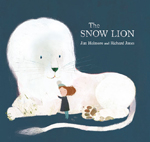 Caro, the young female protagonist, has just moved into a new house with her mum. The house is very white, and so is the huge snow lion that blends into the walls she discovers in it. Throughout the story, which is illustrated in calming colors and powdery white, the snow lion encourages shy Caro to go outside and join the children she sees playing, and she finally does. Mum invites all of Caro’s new friends over for a painting party. Once the house is painted in a variety of colors, Caro is saddened to discover she can’t find the snow lion. When she steps outside where everything is covered in snow, however, she finds the snow lion again. Readers learn that the lion has helped Caro find friends and will continue to be a companion. (Jim Helmore lives in London, England; Richard Jones lives in Devon, England.)
Caro, the young female protagonist, has just moved into a new house with her mum. The house is very white, and so is the huge snow lion that blends into the walls she discovers in it. Throughout the story, which is illustrated in calming colors and powdery white, the snow lion encourages shy Caro to go outside and join the children she sees playing, and she finally does. Mum invites all of Caro’s new friends over for a painting party. Once the house is painted in a variety of colors, Caro is saddened to discover she can’t find the snow lion. When she steps outside where everything is covered in snow, however, she finds the snow lion again. Readers learn that the lion has helped Caro find friends and will continue to be a companion. (Jim Helmore lives in London, England; Richard Jones lives in Devon, England.)
—CBB
Ages 9–11
The Guggenheim Mystery. Robin Stevens. 2018. Knopf/Random House.
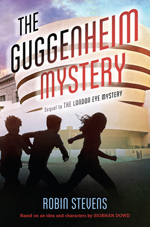 Ted Sparks, the teen sleuth from The London Eye Mystery (2008) by the late British author Siobhan Dowd, gets involved in a second mystery, written by Robin Stevens at the request of the Siobhan Dowd Trust based on Dowd’s intention to write a sequel involving the Guggenheim Museum. On a trip to New York City with Mum and older sister, Kat, for a visit with cousin Salim and aunt Gloria, a newly appointed curator at the Guggenheim, 12-year-old Ted, who describes himself as having a “funny brain, which works on a different operating system than other people’s,” has another opportunity to use his Sherlockian deductive skills. When “In the Black Square,” a famous painting by Wassily Kandinsky, is stolen from the museum and the police quickly make Aunt Gloria the prime suspect, Ted and Kat methodically follow clues and work their way through a list of suspects to recover the painting and exonerate her. (American-born Robin Stevens lives in Oxford, England.)
Ted Sparks, the teen sleuth from The London Eye Mystery (2008) by the late British author Siobhan Dowd, gets involved in a second mystery, written by Robin Stevens at the request of the Siobhan Dowd Trust based on Dowd’s intention to write a sequel involving the Guggenheim Museum. On a trip to New York City with Mum and older sister, Kat, for a visit with cousin Salim and aunt Gloria, a newly appointed curator at the Guggenheim, 12-year-old Ted, who describes himself as having a “funny brain, which works on a different operating system than other people’s,” has another opportunity to use his Sherlockian deductive skills. When “In the Black Square,” a famous painting by Wassily Kandinsky, is stolen from the museum and the police quickly make Aunt Gloria the prime suspect, Ted and Kat methodically follow clues and work their way through a list of suspects to recover the painting and exonerate her. (American-born Robin Stevens lives in Oxford, England.)
—CA
The Tale of Angelino Brown. David Almond. Ill. Alex T. Smith. 2018. Candlewick.
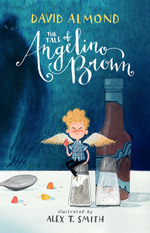 One day as Bert Brown is driving his regular bus route, he discovers a tiny angel in his shirt pocket and brings it home to his wife, Betty. Delighted with their angel boy, they name him Angelino and, reluctantly, Betty sends him to school in compliance with the law. The school children quickly befriend Angelino and begin teaching him how to speak, read, and write. Unfortunately, some devious adults kidnap Angelino, and it’s up to Angelino’s new friends to put their heads together to rescue him. Alex T. Smith’s pencil drawings, featuring charming Angelino and a host of cleverly portrayed villains and heroes, are the perfect complement to master storyteller David Almond’s delightfully cheeky chapter book. (David Almond lives in Northumberland, England; Alex T. Smith lives in Warwickshire, England.)
One day as Bert Brown is driving his regular bus route, he discovers a tiny angel in his shirt pocket and brings it home to his wife, Betty. Delighted with their angel boy, they name him Angelino and, reluctantly, Betty sends him to school in compliance with the law. The school children quickly befriend Angelino and begin teaching him how to speak, read, and write. Unfortunately, some devious adults kidnap Angelino, and it’s up to Angelino’s new friends to put their heads together to rescue him. Alex T. Smith’s pencil drawings, featuring charming Angelino and a host of cleverly portrayed villains and heroes, are the perfect complement to master storyteller David Almond’s delightfully cheeky chapter book. (David Almond lives in Northumberland, England; Alex T. Smith lives in Warwickshire, England.)
—CBB
Ages 12–14
The Dam. David Almond. Ill. Levi Pinfold. 2018. Candlewick Studio/Candlewick.
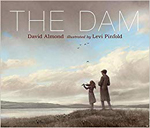 A simple, expressive text and stunning illustrations (done in charcoal, ink, pastels, and digitally) tell the evocative story of a father and daughter’s walk through a desolate valley. They take down the boards nailed over the doors of abandoned cottages and fill each of them one more time with the music of her violin, singing, and dancing in memory of the importance of music in the lives of those who once lived in the valley that will be flooded following the completion of a dam. There is sadness over what is being lost but also hopefulness for the future of the region. “Behind the dam, / within the water, the music stays, / will never be gone.” An endnote includes background for this true story based on the experience of musicians Mike Tickell and his daughter, Kathryn, when the Kielder Dam was constructed in Northumberland, England, in 1981. (David Almond lives in Northumberland, England; Levi Pinfold lives in Queensland, Australia.)
A simple, expressive text and stunning illustrations (done in charcoal, ink, pastels, and digitally) tell the evocative story of a father and daughter’s walk through a desolate valley. They take down the boards nailed over the doors of abandoned cottages and fill each of them one more time with the music of her violin, singing, and dancing in memory of the importance of music in the lives of those who once lived in the valley that will be flooded following the completion of a dam. There is sadness over what is being lost but also hopefulness for the future of the region. “Behind the dam, / within the water, the music stays, / will never be gone.” An endnote includes background for this true story based on the experience of musicians Mike Tickell and his daughter, Kathryn, when the Kielder Dam was constructed in Northumberland, England, in 1981. (David Almond lives in Northumberland, England; Levi Pinfold lives in Queensland, Australia.)
—CA
My Name Is Victoria. Lucy Worsley. 2018. Candlewick.
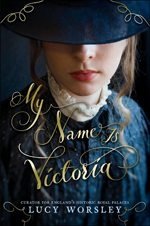 Lucy Worsley, historian, author, and chief curator at Historic Royal Palaces (including Kensington Palace), writes about an alternative course of events leading up to Queen Victoria’s coronation, loosely based on the queen’s letters and diaries. Victoria Conroy (Miss V) is taken to Kensington Palace by her father, Sir John Conroy, and told that she will become the companion of Princess Victoria. Under the Kensington System, there are strict rules that the young princess must follow to avoid being killed, which include staying inside (and playing behind the couch) most of the time. Miss V becomes friends with the Princess Victoria but is torn between loyalty to the princess and her father as she learns several secrets during her stay at Kensington Palace and must make some difficult decisions. In an epilogue, Worsley provides background for her imaginative novel of an alternate history of Queen Victoria’s childhood. (Lucy Worsley lives in London, England.)
Lucy Worsley, historian, author, and chief curator at Historic Royal Palaces (including Kensington Palace), writes about an alternative course of events leading up to Queen Victoria’s coronation, loosely based on the queen’s letters and diaries. Victoria Conroy (Miss V) is taken to Kensington Palace by her father, Sir John Conroy, and told that she will become the companion of Princess Victoria. Under the Kensington System, there are strict rules that the young princess must follow to avoid being killed, which include staying inside (and playing behind the couch) most of the time. Miss V becomes friends with the Princess Victoria but is torn between loyalty to the princess and her father as she learns several secrets during her stay at Kensington Palace and must make some difficult decisions. In an epilogue, Worsley provides background for her imaginative novel of an alternate history of Queen Victoria’s childhood. (Lucy Worsley lives in London, England.)
—CBB
Ages 15+
The State of Grace. Rachael Lucas. 2018. Feiwel and Friends.
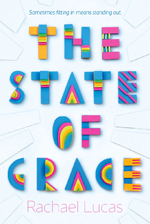 Autistic 15-year-old Grace describes life as “a complicated game.” Grace’s experiences are presented from her perspective in this honest and witty novel by Rachael Lucas, whose daughter is autistic. Grace loves her horse Mabel, her sister Leah, her best friend Anna, and Gabe (the most popular boy in school and her first boyfriend). However, she’s not a fan of her mother’s friend Eve, who has been hanging around frequently since her father, a filmmaker, has been away. Grace makes some unwise decisions in an effort to fit in at school and work through uncertain and unpredictable family issues as well as deal with friendships and first love. (Rachael Lucas lives in North West England.)
Autistic 15-year-old Grace describes life as “a complicated game.” Grace’s experiences are presented from her perspective in this honest and witty novel by Rachael Lucas, whose daughter is autistic. Grace loves her horse Mabel, her sister Leah, her best friend Anna, and Gabe (the most popular boy in school and her first boyfriend). However, she’s not a fan of her mother’s friend Eve, who has been hanging around frequently since her father, a filmmaker, has been away. Grace makes some unwise decisions in an effort to fit in at school and work through uncertain and unpredictable family issues as well as deal with friendships and first love. (Rachael Lucas lives in North West England.)
—CBB
Chelsey M. Bahlmann Bollinger is an assistant professor in the Early, Elementary, and Reading Department at James Madison University, in Harrisonburg, Virginia. Carolyn Angus is former director of the George G. Stone Center for Children's Books, Claremont Graduate University, in Claremont, California.
These reviews are submitted by members of the International Literacy Association's Children's Literature and Reading Special Interest Group (CL/R SIG) and are published weekly on Literacy Daily.